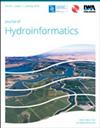Scale effects and implications of the stochastic structure of customer water demands
IF 2.2
3区 工程技术
Q3 COMPUTER SCIENCE, INTERDISCIPLINARY APPLICATIONS
引用次数: 0
Abstract
The effect of different temporal (from seconds to months) and spatial aggregation scales (from individual users to full urban areas) on water demand behavior has been explored to a limited degree. The effort described here extends those works by evaluating the scale effects of residential water consumption in a unique US data set that covers 10,000 households with a 1-gallon (3.79 L) hourly resolution over 2 years. A preliminary data analysis and a sequential Principal Component Analysis (PCA) is carried out to assess the effect of different temporal (weekly, daily, hourly) and spatial aggregation (individual meters and groups every 10, 100 and 1,000 m) levels on demand. Results show that individual users act very differently from each other, and individual consumer variability is only canceled out when a significant number of households are aggregated. The implications of this finding are assessed from a hydraulic modeling perspective as the spatiotemporal scale of measurements may condition the type of analysis that can be carried out in practice. However, additional work is needed to explore the point at which it may be worth to embrace a micro (per fixture/household) or a macro (per node/network) approach for different purposes.用户需水量随机结构的规模效应和影响
不同的时间(从几秒到几个月)和空间聚合尺度(从单个用户到整个城市区域)对需水行为的影响的研究还很有限。本文所描述的工作是对这些工作的延伸,通过一个独特的美国数据集来评估居民用水量的规模效应,该数据集覆盖了 10,000 个家庭,每小时分辨率为 1 加仑(3.79 升),历时两年。通过初步数据分析和连续主成分分析 (PCA),评估了不同时间(每周、每天、每小时)和空间聚合(单个水表和每 10 米、100 米和 1000 米一组)水平对需求的影响。结果表明,单个用户之间的行为差异很大,只有当大量家庭聚集在一起时,单个消费者的变化才会被抵消。我们从水力模型的角度评估了这一发现的影响,因为测量的时空尺度可能会影响实际分析的类型。不过,还需要做更多的工作,以探讨在什么情况下值得采用微观(每个固定装置/住户)或宏观(每个节点/网络)的方法来达到不同的目的。
本文章由计算机程序翻译,如有差异,请以英文原文为准。
求助全文
约1分钟内获得全文
求助全文
来源期刊

Journal of Hydroinformatics
工程技术-工程:土木
CiteScore
4.80
自引率
3.70%
发文量
59
审稿时长
3 months
期刊介绍:
Journal of Hydroinformatics is a peer-reviewed journal devoted to the application of information technology in the widest sense to problems of the aquatic environment. It promotes Hydroinformatics as a cross-disciplinary field of study, combining technological, human-sociological and more general environmental interests, including an ethical perspective.
 求助内容:
求助内容: 应助结果提醒方式:
应助结果提醒方式:


